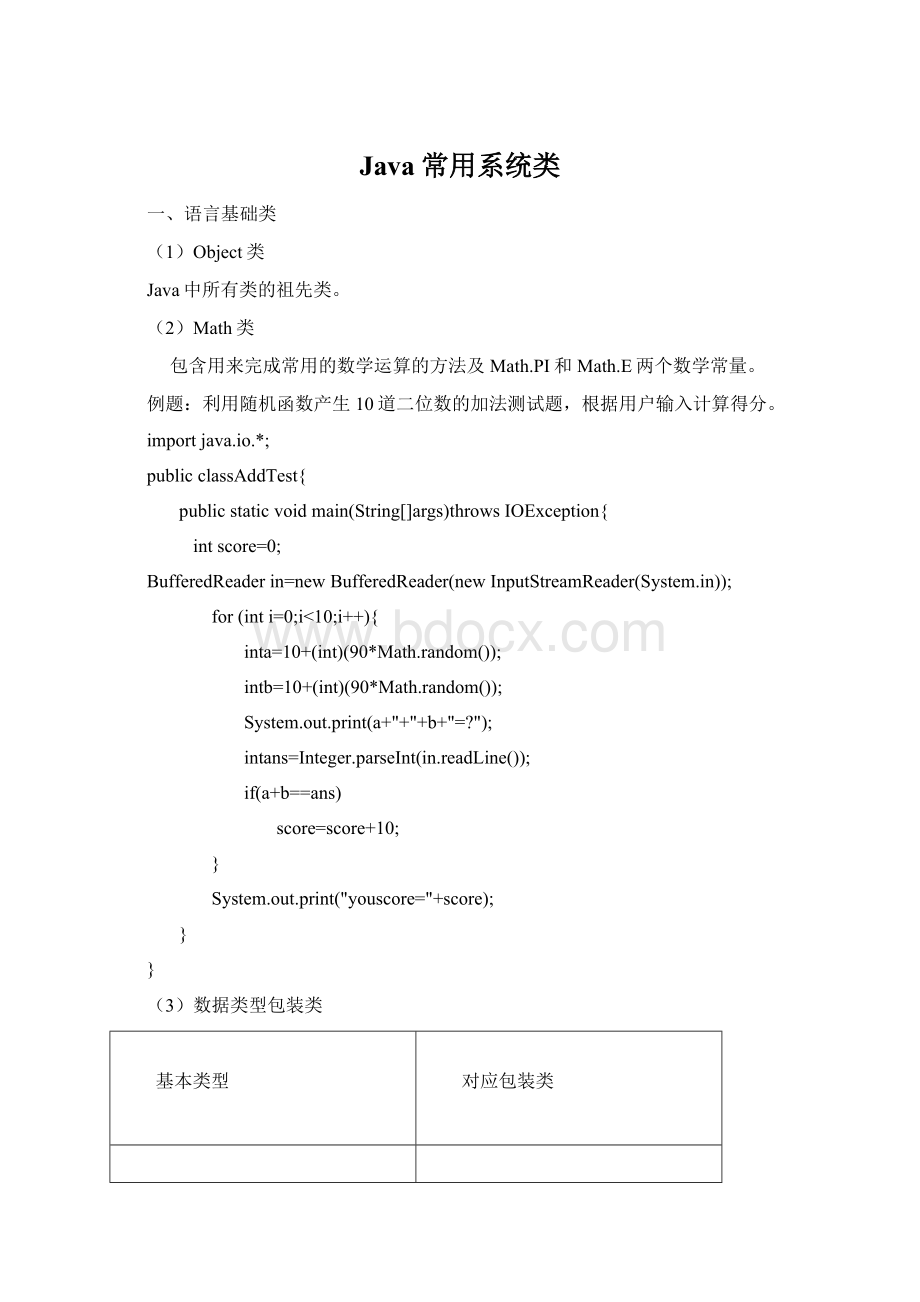Java常用系统类Word文档格式.docx
《Java常用系统类Word文档格式.docx》由会员分享,可在线阅读,更多相关《Java常用系统类Word文档格式.docx(15页珍藏版)》请在冰豆网上搜索。

System.out.print("
youscore="
+score);
}
(3)数据类型包装类
基本类型
对应包装类
boolean
Boolean
char
Character
byte
Byte
short
Short
int
Integer
long
Long
float
Float
double
Double
publicclassE437{
publicstaticvoidmain(Stringargs[]){
chara[]={'
a'
'
b'
c'
D'
E'
F'
};
for(inti=0;
a.length;
if(Character.isLowerCase(a)){
a=Character.toUpperCase(a);
elseif(Character.isUpperCase(a)){
a=Character.toLowerCase(a);
+a);
}
二、字符串
(1)String类:
创建不可变长的字符串
①创建字符串
Strings1=“abc”;
Strings2=newString(“abc”);
…
②比较两个字符串
==和equals()方法。
classTestEquals{
publicstaticvoidmain(String[]args){
Strings1="
abc"
;
Strings2="
Strings3=newString("
Strings4=newString("
System.out.println(s1==s2);
System.out.println(s2==s3);
System.out.println(s3==s4);
System.out.println(s1.equals(s2));
System.out.println(s1.equals(s3));
③字符串的其他常用方法
length():
字符串的长度,即字符串中字符的个数。
concat(Stringstr):
字符串的连接。
“+”:
indexOf(intch):
在当前的字符串中查找字符ch,从前向后找。
lastIndexOf(intch):
在当前的字符串中查找字符ch,从后向前找。
字符串的分析:
StringTokenizer类。
importjava.util.*;
publicclassWordAnalyse{
StringTokenizerst=newStringTokenizer("
helloeverybody"
while(st.hasMoreTokens()){//判断是否有后续单词。
System.out.println(st.nextToken());
//取下一个单词。
publicString[]split(Stringregex)方法:
使用指定分隔符分离字符串。
publicclassTestSplit{
Strings=newString("
boo:
and:
foo"
for(Strings1:
s.split("
:
))
System.out.println(s1);
(2)StringBuffer类:
创建可变长的字符串
①创建StringBuffer对象
publicStringBuffer():
创建一个空的StringBuffer对象。
publicStringBuffer(intlength):
创建一个长度为length的StringBuffer对象。
publicStringBuffer(Stringstr):
用字符串str初始化StringBuffer对象。
②StringBuffer的主要方法
classTestStringBuffer{
publicstaticvoidmain(String[]args){
StringBufferstr=newStringBuffer();
str.append("
Hello"
Mary!
str.insert(6,"
good"
str.setCharAt(6,'
G'
str.deleteCharAt(15);
str.replace(11,15,"
Tom"
System.out.println(str);
(3)StringBuilder类(JDK5.0开始):
StringBuilder不支持同步。
StringBuffer支持同步。
性能:
StringBuilder>
StringBuffer>
String
publicclassTestB{
finalstaticintttime=100000;
//测试循环次数
publicTestB(){}
publicvoidtest(Strings){
longbegin=System.currentTimeMillis();
for(inti=0;
ttime;
s+="
add"
longover=System.currentTimeMillis();
System.out.println("
操作"
+s.getClass().getName()+"
类型使用的时间为:
+(over-begin)+"
毫秒"
publicvoidtest(StringBuffers){
s.append("
publicvoidtest(StringBuilders){
publicvoidtest2(){
Strings2="
abadf"
Strings=s2+s2+s2;
操作字符串对象引用相加类型使用的时间为:
publicvoidtest3(){
Strings="
操作字符串相加使用的时间为:
Strings1="
StringBuffersb1=newStringBuffer("
StringBuildersb2=newStringBuilder("
TestBt=newTestB();
t.test(s1);
t.test(sb1);
t.test(sb2);
t.test2();
t.test3();
三、Vector类
Vector类实现了可扩展的对象数组。
测试向量的大小及容量的变化。
importjava.util.*;
publicclassTestCapacity{
Vectorv=newVector();
System.out.println("
size="
+v.size());
capacity="
+v.capacity());
14;
v.add("
hello"
Afteradded14Elements"
(1)给向量序列尾部添加新元素
(2)获取向量序列中元素
(3)查找向量序列中元素
(4)修改向量序列中元素
(5)删除向量序列中元素
(6)向量的遍历访问
向量的添加、获取、修改、删除和遍历。
publicclassTestVector{
v.addElement("
def"
xyz"
v
(1)="
+v.elementAt
(1));
+v.get
(1));
System.out.println(v);
v.setElementAt("
DEF"
1);
v.removeElementAt
(1);
v.size();
System.out.print(v.get(i)+"
"
System.out.println();
Iteratorx=v.iterator();
while(x.hasNext())
System.out.print(x.next()+"
四、CollectionAPI简介
在JavaAPI中为了支持各种对象的存储访问提供了Collection(收集)系列API,Vector是这种类型的一种。
(1)Collection接口及实现层次
接口Collection处于CollectionAPI的最高层次,其中定义了所有底层接口或类的公共方法,如下图所示:
file:
///C:
/Users/SBT/AppData/Local/Temp/msohtmlclip1/09/clip_image001.gif
①Collection接口
l
booleanadd(Objecto):
将一个对象加入到收集中。
booleancontains(Objecto):
判断收集中是否包含指定对象。
booleanisEmpty():
判断收集是否为空。
Iteratoriterator():
取得遍历访问收集的迭代子对象。
booleanremove(Objecto):
从收集中删除某对象。
intsize():
获取对象的大小。
Object[]toArray():
将收集元素转化为对象数组。
voidclear():
删除收集中所有的元素。
②Set接口
该接口是数学上集合模型的抽象,有两个特点:
一是不含重复元素,而是无序。
publicclassTestSet{
publicstaticvoidmain(String[]args){
HashSeth=newHashSet();
h.add("
Str1"
h.add(newInteger(12));
h.add(newDouble(4.2));
h.add(newString("
));
System.out.println(h);
③List接口
该接口类似于数学上数列的模型,也称序列。
其特点是可含有重复元素,而且是有序的。
★
类ArrayList内部使用基于动态数组的数据结构。
类LinkedList内部使用基于链表的数据结构。
对于随机访问get和set,ArrayList要优于LinkedList,因为linkedList要移动指针。
对于新增和删除元素操作add和remove,LinkedList比较占优势,因为ArrayList要移动数据。
importjava.util.*;
publicclassTestList{
publicstaticvoidmain(String[]args){
ArrayLista=newArrayList();
a.add("
a.add(newInteger(12));
a.add(newDouble(4.2));
a.add(newString("
System.out.println(a);
//或者使用迭代器访问a中的元素
Iteratorp=a.iterator();
while(p.hasNext()){
System.out.print(p.next()+"
"
publicclassListDemo2{
finalintN=50000;
longtimeList(Listst){
longstart=System.currentTimeMillis();
for(inti=0;
N;
Objectobj=newInteger(i);
st.add(obj);
longstop=System.currentTimeMillis();
return(stop-start);
ListDemo2l=newListDemo2();
timeforArrayList="
+l.timeList(newArrayList()));
timeforLinkedList="
+l.timeList(newLinkedList()));
(2)Map接口及实现层次
除了Collection表示的这种单一对象数据集合,对于“”表示的数据集合在CollectionAPI提供了Map接口。
Map接口及其子接口的实现层次如下图:
/Users/SBT/AppData/Local/Temp/msohtmlclip1/09/clip_image002.gif
importjava.u